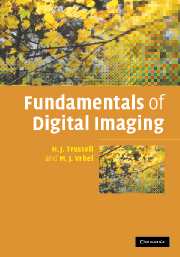Book contents
- Frontmatter
- Contents
- Preface
- Acknowledgments
- 1 Introduction
- 2 Mathematical representation
- 3 Elementary display of images
- 4 Quantization
- 5 Frequency domain representation
- 6 Spatial sampling
- 7 Image characteristics
- 8 Photometry and colorimetry
- 9 Color sampling
- 10 Image input devices
- 11 Image output devices and methods
- 12 Characterization of devices
- 13 Estimation of image model parameters
- 14 Image restoration
- A Generalized functions and sampling representation
- B Digital image manipulation and matrix representation
- C Stochastic images
- D Multidimensional look-up tables
- E Psychovisual properties
- References
- Index
12 - Characterization of devices
Published online by Cambridge University Press: 06 July 2010
- Frontmatter
- Contents
- Preface
- Acknowledgments
- 1 Introduction
- 2 Mathematical representation
- 3 Elementary display of images
- 4 Quantization
- 5 Frequency domain representation
- 6 Spatial sampling
- 7 Image characteristics
- 8 Photometry and colorimetry
- 9 Color sampling
- 10 Image input devices
- 11 Image output devices and methods
- 12 Characterization of devices
- 13 Estimation of image model parameters
- 14 Image restoration
- A Generalized functions and sampling representation
- B Digital image manipulation and matrix representation
- C Stochastic images
- D Multidimensional look-up tables
- E Psychovisual properties
- References
- Index
Summary
Having discussed the common devices used to obtain and display images, we now focus on achieving accuracy in the recording and reproduction process through device characterization. Device characterization is the problem of determining the relationship between device-dependent values and photometric values. Device-dependent values include the control values sent to an output device, e.g., CMYK, RGB, and values received from an input device, e.g., RGB. Photometric values include CIE colorimetric or photometric values and ANSI or ISO status density values.
The methods for characterization can be divided into parametric and nonparametric based approaches. The parametric based methods require the estimation of model parameters using data collected from a photometric or colorimetric instrument. The nonparametric based methods require the estimation of look-up table (LUT) entries or artificial neural network coefficients. In this chapter, the problem of device characterization is presented in a general framework, which can be applied to a wide variety of devices.
Goal of characterization
The need for device characterization is best illustrated by a simple example, in which the goal is to record and display a copy of an image such that a “best” visual match is made to the original image. There are essentially two approaches to this problem. One approach would be to determine a mapping from the recorded values directly to the reproduction device control values as shown in Fig. 12.1. This approach is often defined as being a closed loop solution [239], since the mapping will work only for that specific input and output device.
Information
- Type
- Chapter
- Information
- Fundamentals of Digital Imaging , pp. 344 - 389Publisher: Cambridge University PressPrint publication year: 2008
